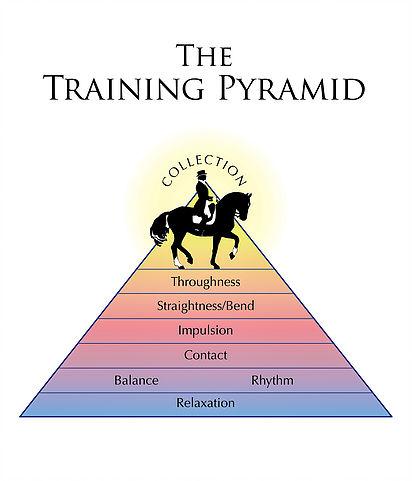
Chakras & the Training Pyramid: Part 3
Contact and the solar plexus chakra.
As we continue this series, this week we will be talking about the solar plexus chakra and contact.
The solar plexus chakra is located in the abdominal area between the navel and the breastbone. This chakra is associated with one’s self-esteem, confidence, emotional balance, and the power of transformation. It is also thought to control digestion and metabolism. The solar plexus chakra aligns with the ability to set healthy boundaries.
The similarities to the practice of “contact” when riding are numerous and profound.

This illustration first appeared in the November 1997 issue of Dressage Today magazine (DressageToday.com). Used here with permission.
Teaching a horse to accept contact with the bit is one small part of establishing healthy boundaries in the riding partnership. To achieve this, both horse and rider must be relaxed, balanced, and move together in a harmonious, steady rhythm in all the gaits.
The primary responsibility for soft, consistent contact resides with the rider. While the bit rests in the horse’s mouth, “contact” is actually established first in the rider’s seat and legs, as these elements encourage the horse forward into contact, through the bit, with accepting hands that must remain soft and following with each and every stride.
This “circle” of energy flows with each stride, from the rider’s lower back and seat, and through the horse’s spine and from the rider’s legs through the horse’s ribcage. The energy, if applied correctly, should bring the entire rear of the horse forward with it, such that the horse carries the rear half of his body slightly more beneath himself, including the hind feet. The energy then travels up the horse’s shoulder through his neck vertebrae, down the face, and to the bit, where it returns via a soft jaw back to the softly accepting hands of the rider, thus creating an infinity loop of energy.
It is important to remember that contact begins in the rider’s lower back and seat, not the rider’s hands. The energy created by this soft contact is then enhanced, or amplified, by the horse.
The benefits of a gentle-but-consistent contact are remarkable. The horse’s confidence in his rider is enhanced. With additional confidence in his rider, the horse’s confidence (emotional balance) and his self-esteem (self-carriage) are enhanced. Indeed, the horse’s way of going will be literally transformed, as he rebalances his entire body from the natural weight distribution (60% or more on the forehand) to, eventually, true “self-carriage” (60% or more on the haunches).
In the photo below, adult amateur rider Dara Lindner demonstrates a soft, flowing contact, and the young horse she is riding responds by stepping well under his body with his hind, while at the same time allowing the energy to flow forward through his body, down his face, and back to Dara’s hands in a soft, continuous loop of forward energy.
Note the solar plexus region of the rider – she has a solid core that is open to forward energy flow; she is moving the horse forward with her pelvic bones and her leg. Contact begins here, and, if done correctly, and oft-noted “straight line from elbow to bit” occurs naturally, with neither horse nor rider pulling nor manipulating the contact in any way. The energy flow, thus contact, is allowed to happen as the horse moves up-and-forward through his body.
As an additional bonus, this “infinity loop” concept for contact strengthens the core muscles of both rider and horse, which is one key requirement to balance the solar plexus chakra. And, with contact thus established correctly, the use of half-halts can be very light and subtle, thus maximizing the harmonious communication between rider and horse.
Next in this series: the heart chakra and impulsion.






Leave a Comment